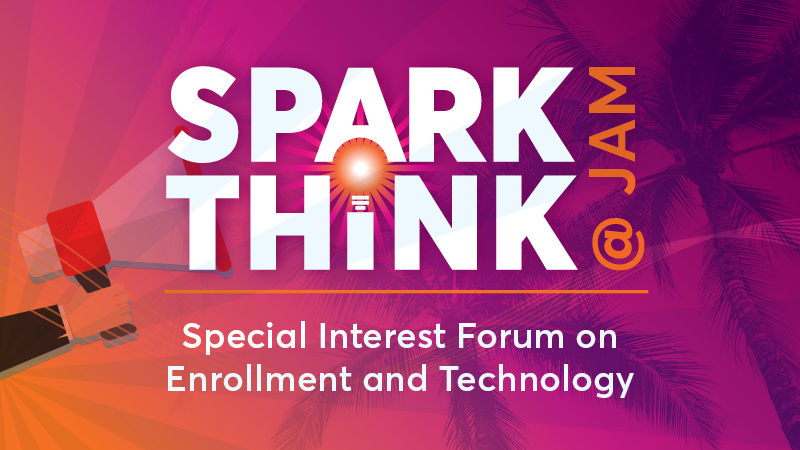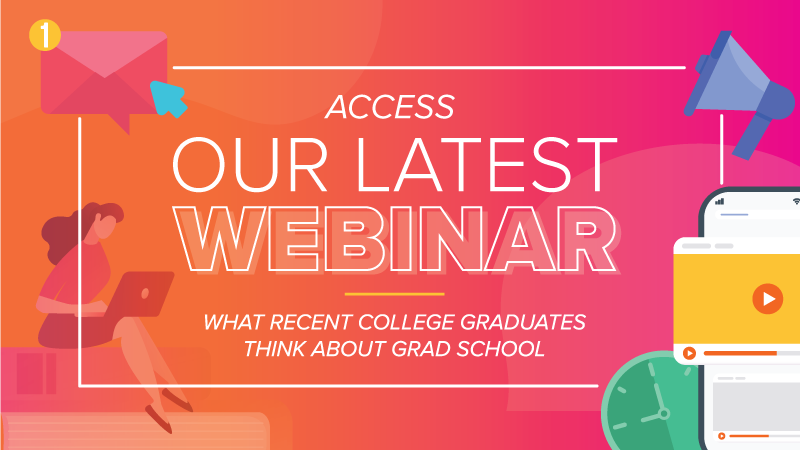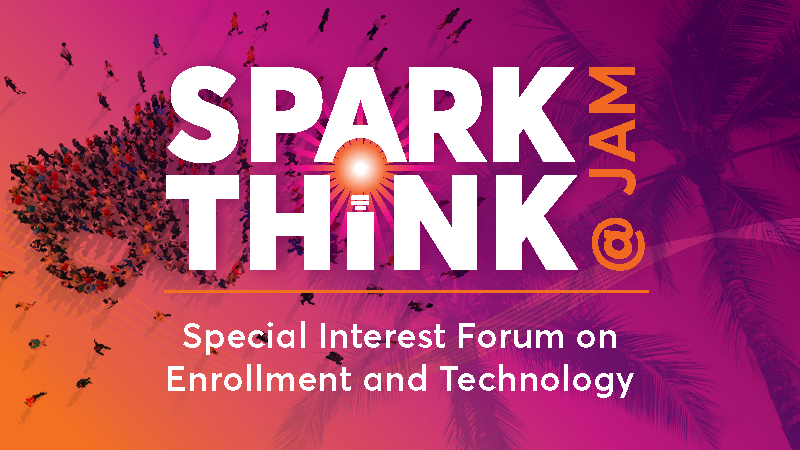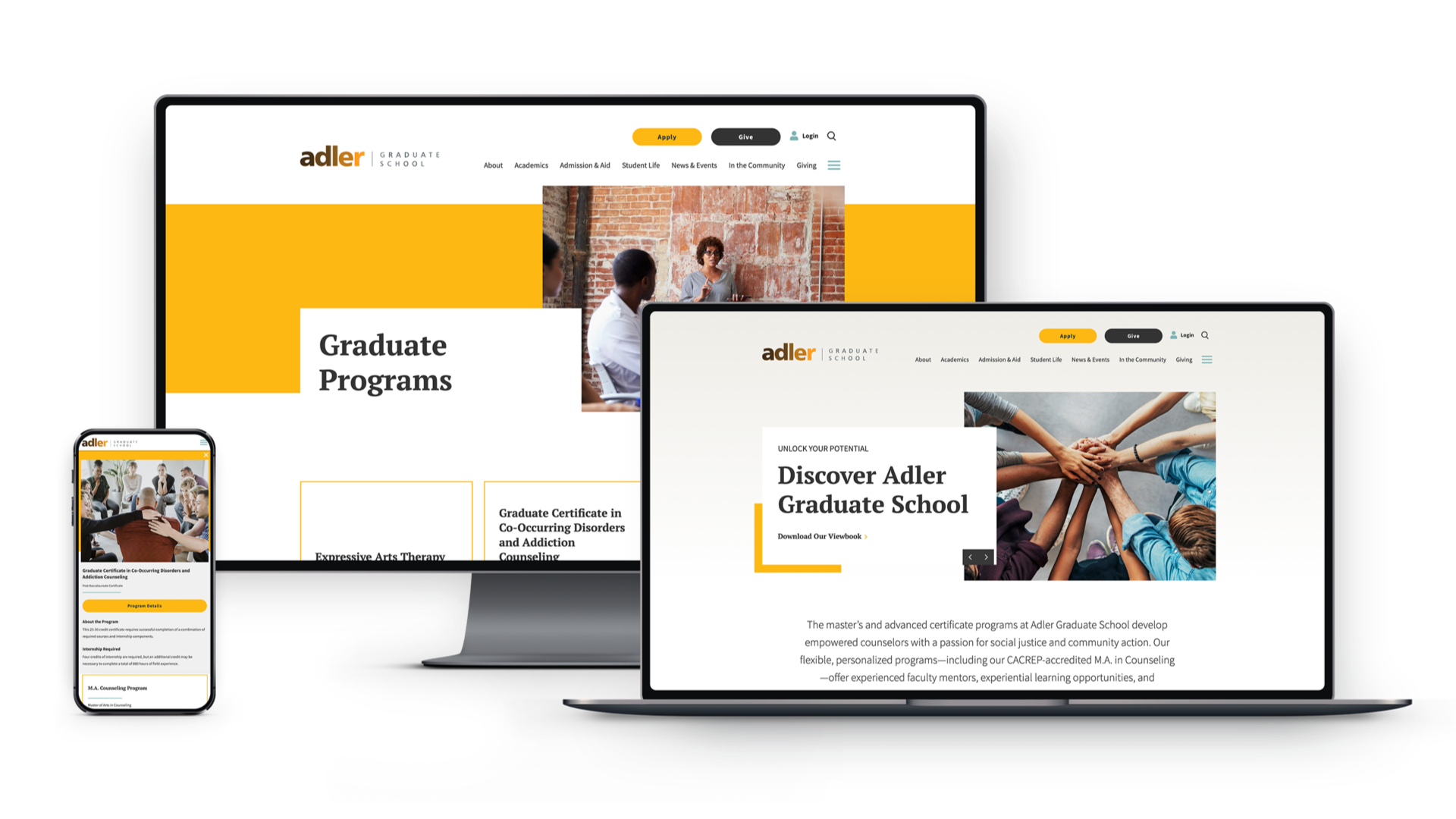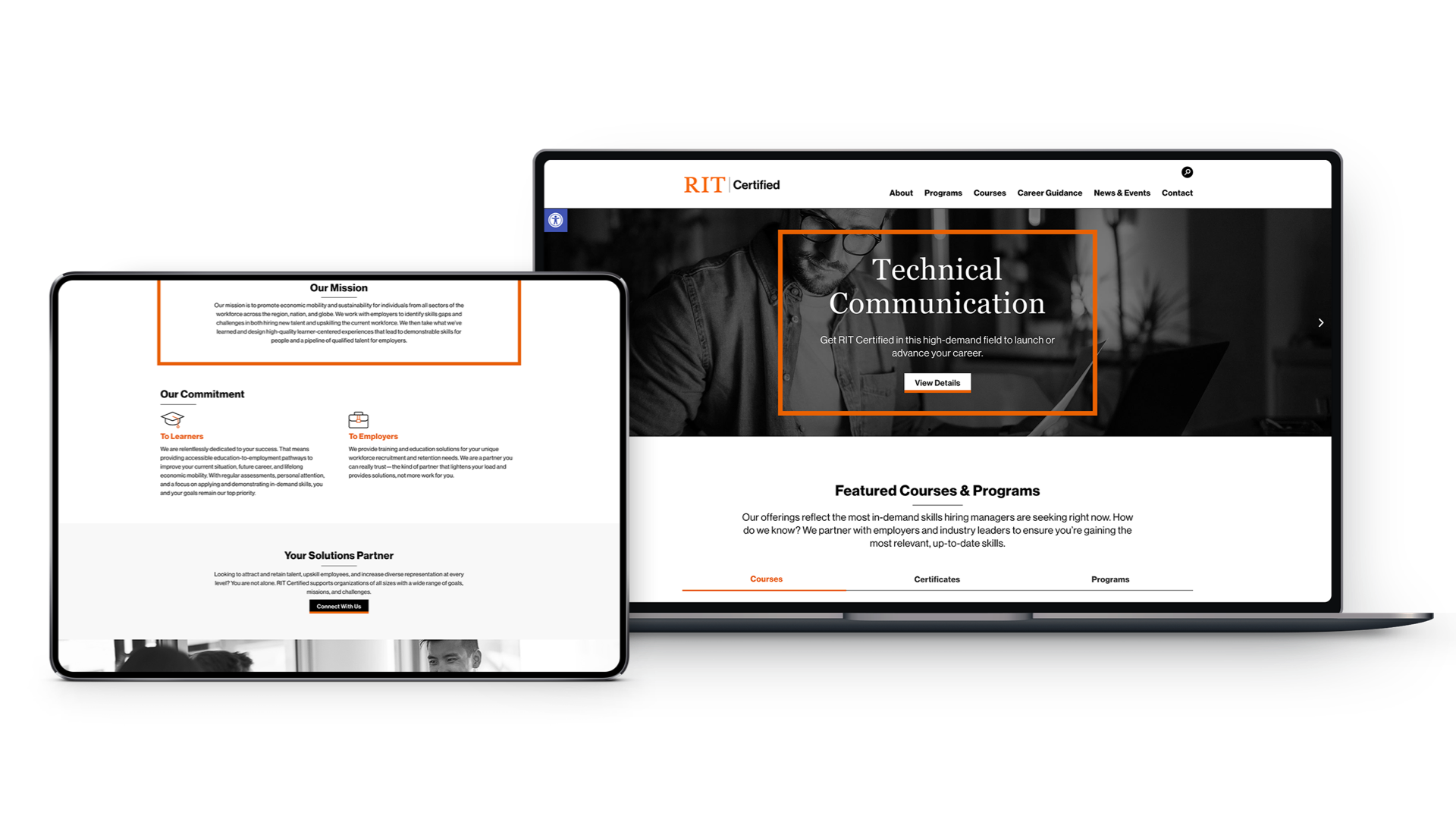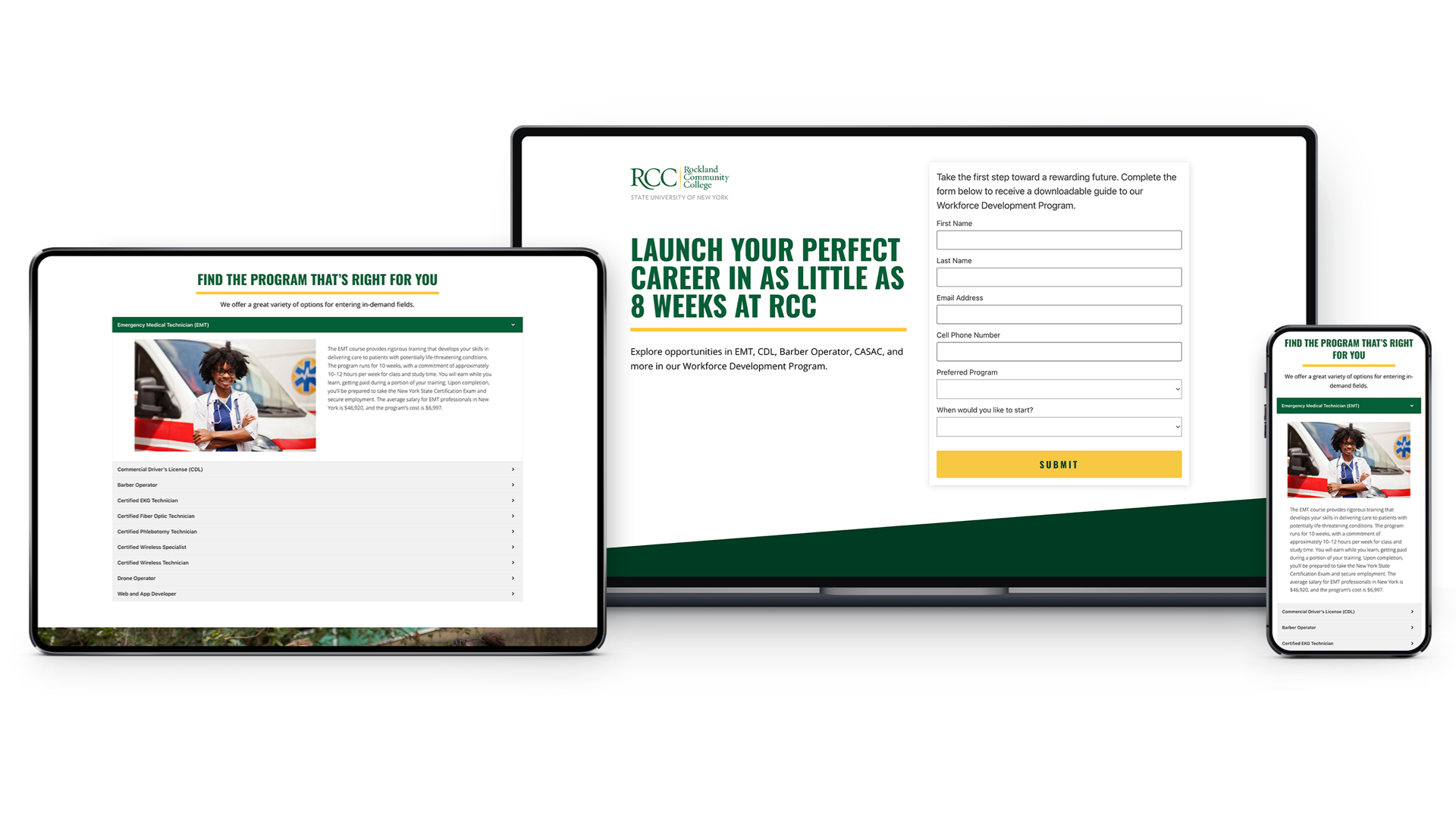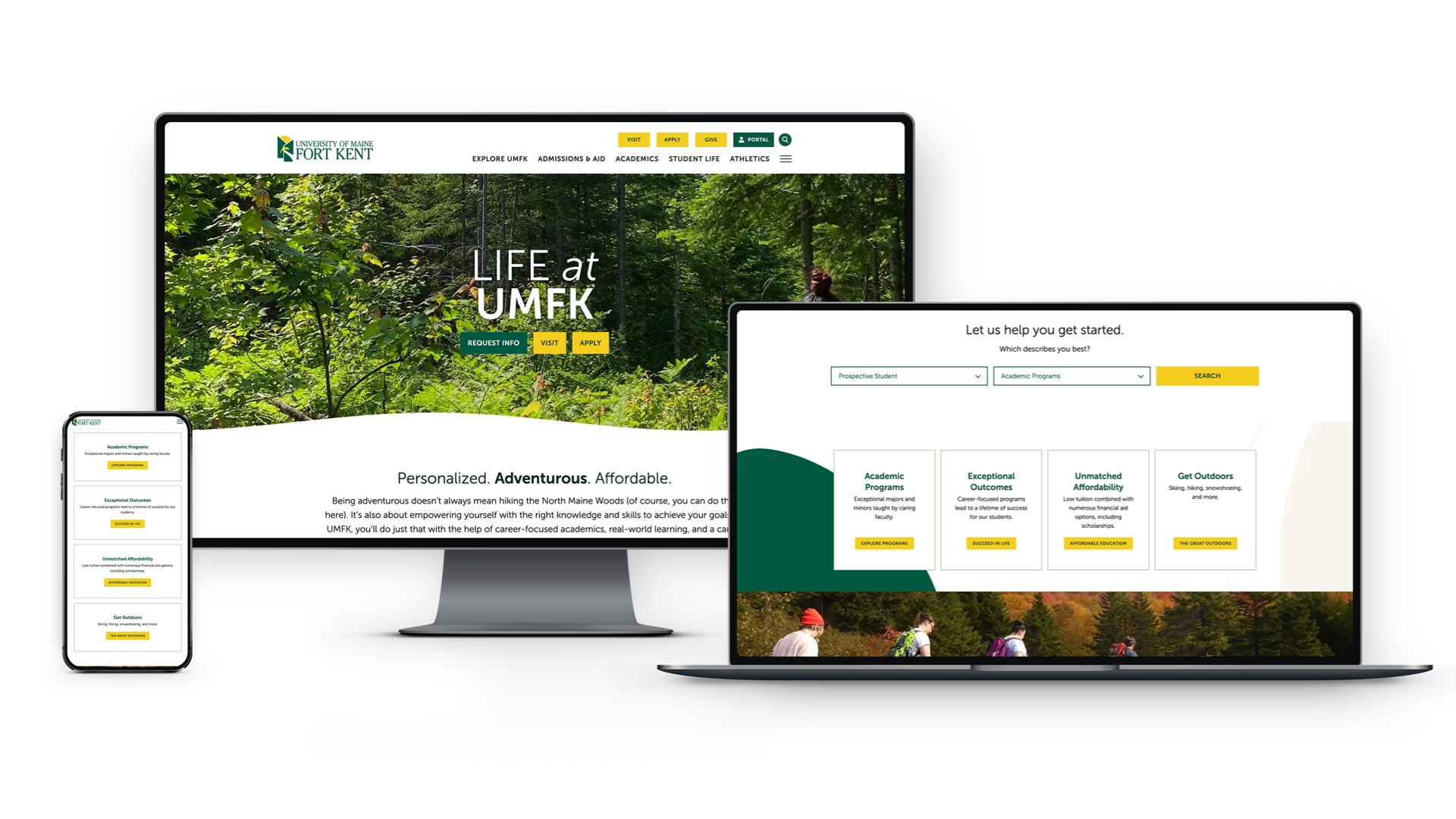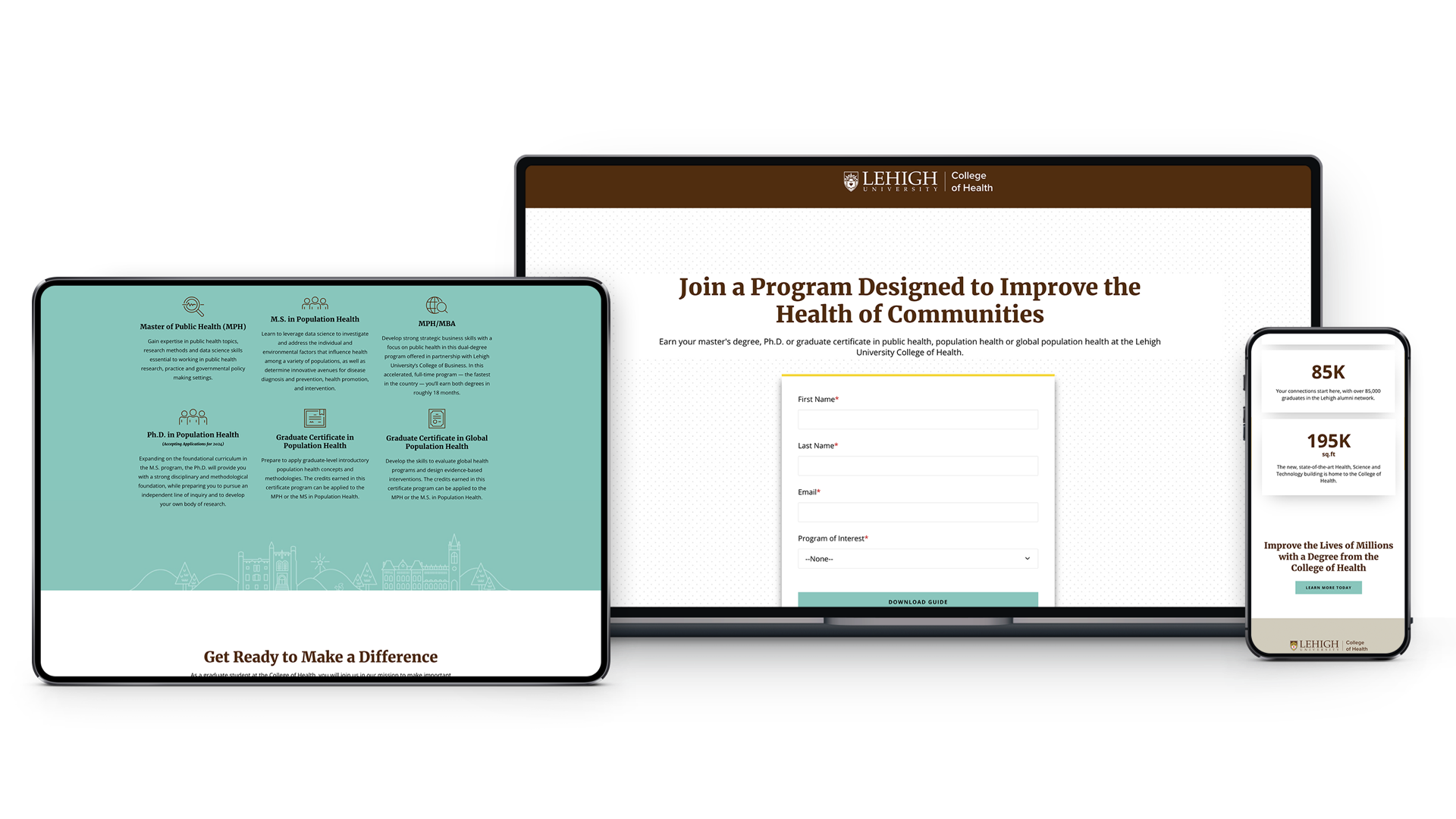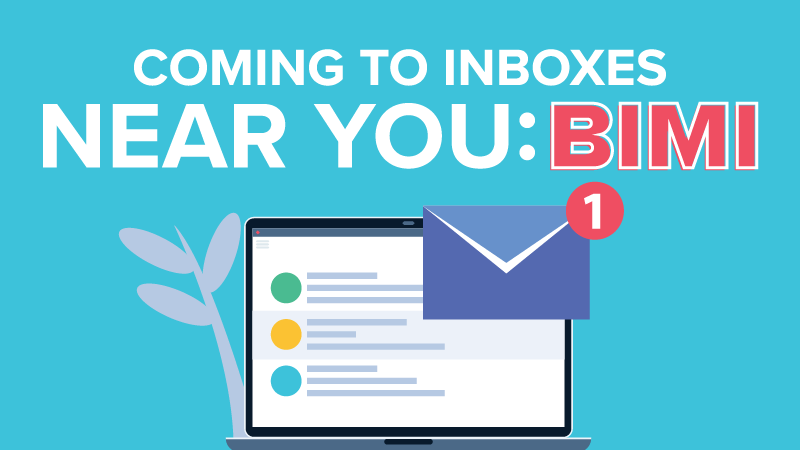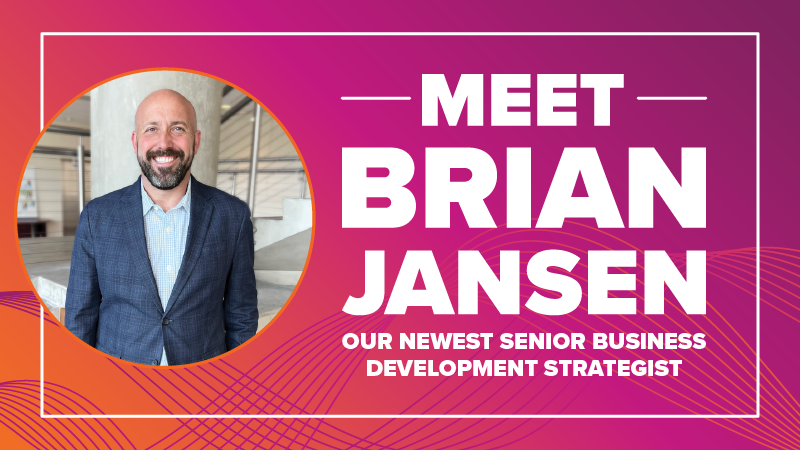Registration Is Now Open For SparkThink@JAM
Registration Is Now Open For SparkThink@JAM
Wednesday, May 31–Friday, June 2, 2023 • Orlando, FL
We’re thrilled to announce that registration is now open for SparkThink@JAM, our first annual special interest forum on enrollment marketing, strategy, and technology!
Taking place during this year’s 22nd Jenzabar Annual Meeting (JAM), SparkThink@JAM will bring together enrollment marketing and admissions leaders for engaging sessions and discussions that support the advancement of the higher ed community, as well as your own professional and personal development. By sharing diverse perspectives and experiences, you’ll be inspired with new ideas and tactics for engaging your target markets and elevating your recruitment campaigns and practices.
SparkThink@JAM will offer attendees 3 days of educational sessions, roundtable discussions, and networking opportunities, as well as a one-of-a-kind experience at the Gaylord Palms Resort & Convention Center, just minutes from Walt Disney World Resort and Universal Studios.
We can’t wait to see you there! If you have any questions, feel free to reach out.
What Recent College Graduates Think About Grad School
You already know graduate school is a perennially attractive option for students seeking additional credentials, career advancement, or a career change. However, evolving technological habits and other factors can reshape what prospective students expect from their graduate school experience.
In our recent webinar, Director of Client Strategy Meryl McDonough and Associate Client Strategist Jenna Shipley released the findings of Spark451’s latest Graduate School Intenders Survey, which features feedback from more than 1,000 recent college graduates.
Watch the recording to gain insights about:
- Which factors students value most when assessing grad programs
- Students’ communication preferences and social media habits
- Respondents’ employment status
- Delivery format preferences
- And so much more!
You’ll also have the opportunity to download the full report!
SparkThink@JAM Call for Session Proposals
Calling all admissions and marketing thought leaders! Here’s your opportunity to share your unique wisdom and help support the advancement of the higher education community. The teams at Spark451 and Jenzabar invite you to submit a session proposal for consideration for the 2023 SparkThink@JAM Special Interest Forum on Enrollment and Technology.
Call For Session Proposals Is Now Closed
Share some of the great work you’ve been doing on campus with an audience of your peers at the Gaylord Palms Resort in Orlando, FL, from Wednesday, May 31–Friday, June 2, 2023. Accepted presenters will receive complimentary registration to this 3-day event, featuring a full schedule of educational sessions, roundtable discussions, and networking opportunities.
Each session will run for 60 minutes and should be focused on 1 of 3 core areas: enrollment strategy, marketing communications, and data/operations. Looking for inspiration? Potential topics may include:
- Unique admissions and/or enrollment marketing challenges and solutions
- Preparing for the upcoming “Enrollment Cliff”
- Increasing diversity and/or being mindful of diversity in recruitment
- Unexpected ways to connect with unique audiences (ex: adult degree completion, parent engagement, influencers, etc.)
- Responses/solutions to recent newsworthy higher ed events (ex: Supreme Court case on affirmative action)
The Planning Committee looks forward to reviewing your topic as we collectively work to support the professional and personal development of our attendees and the higher ed community. The deadline to submit your proposal for consideration is March 1, 2023.
What is SparkThink@JAM: Special Interest Forum on Enrollment and Technology?
Taking place during this year’s 22nd Jenzabar Annual Meeting (JAM), SparkThink@JAM is a new session track dedicated to sharing information and ideas on topics related to enrollment management, admissions, strategy, marketing, and technology. It will offer attendees three days of educational sessions, roundtable discussions, and networking opportunities.
This spring, more than 1,300 of your colleagues will be heading to JAM to focus on higher ed tech and the platforms driving your institutions. We hope you’ll join them — and us — in Orlando for a meaningful and memorable event focused on the latest innovations in admissions and enrollment marketing.
Additional details and registration information will follow.
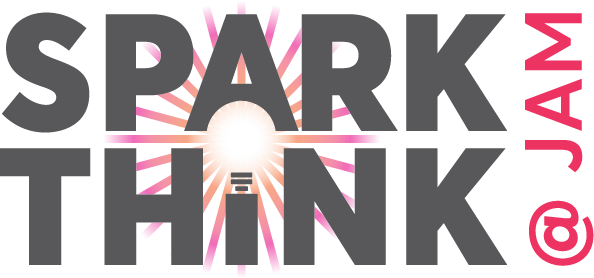
SparkThink@JAM
Wednesday, May 31–Friday, June 2, 2023
Gaylord Palms Resort, Orlando, FL
We can’t wait to see you there! If you have any questions, feel free to reach out.
3 Tips To Increase Your Admitted Student Yield
Yield is a unique yet vulnerable time in the enrollment cycle for higher education institutions. Admitted students can choose to either commit to your university or simply go elsewhere. Successful yield involves engaging your admitted students early, and often, by offering meaningful information to the students and their families. Most importantly, engaging students means building relationships and a foundation of trust at every opportunity.
When students begin their college search, they start by visiting campuses that have piqued their interest. Once a student steps foot on campus, they want to feel personally connected, and many institutions are very skilled at tapping into these feelings. During tours, students start imagining themselves in various settings on campus. They think about what it would be like to eat at the dining hall, play volleyball in the quad, work out at the gym, and study in the beautiful library.
All of these feelings are likely a large part of what drives them to apply. However, after a student submits an application, it’s common for institutions to continue focusing exclusively on recruitment and application generation. In some cases, months can go by between the time a student is admitted and when the school engages them again during yield season. This is a critical problem. During this gap period, the student could be visiting other campuses, receiving communications from other institutions about applying, hearing from school ambassadors about attending a class with them, and so forth. In short, these admitted students are being continually engaged by other schools, which means that the schools that admitted them earlier in the season could be at risk of becoming a distant memory.
The reality is that institutions can’t control the decisions that students ultimately make on where they will attend, but what they can do is create more strategic and impactful communications and position themselves in a way that builds trust with prospective students and informs their decision-making. Here are three tips that can help you focus your yield efforts and maximize your reach with your admitted student pool.
Tip 1: Use Your CRM to Strategically Personalize Outreach
Have you ever seen the inbox of a student who recently took the PSAT or SAT and scored really well? I have, and there are literally hundreds of emails from colleges and universities. These communications become white noise; the student no longer pays attention to the emails because there are just so many.
However, let’s say that your school was able to push through the white noise and garner an application from this highly sought-after student, and you have admitted them. You can be sure that this student has plenty of offers to choose from. This begs the question: What can your institution do to stand out from other schools?
Oftentimes, communications are sent as a means of sharing information and do not warrant a response. For example:
“Reminder: Spark University is having our Admitted Student Day on 3/11. Click here to register.”
These messages have a purpose in that we want to remind the student to register for Admitted Student Day. However, we want to mix these types of communications with more personalized messages that encourage the recipient to start a conversation with you. One example of a personalized message might look like:
“Hi, this is Julie, your Admissions Counselor at Spark University. Congrats on being admitted to Spark! I saw you visited campus last week. Are there any questions that came up after you got home?”
This type of message serves multiple purposes. It is a nice introduction of your admissions staff member; it provides a specific point of contact for that student; and the message is personalized to them and their experience.
You may be thinking, “How can my busy staff send out so many personalized messages to admitted students? How do I make time for this?” With your CRM, you can efficiently deliver personalized messages to your admitted students at scale. (Need help? The Spark451 team has experience creating, sending, and managing personalized communication workflows in whichever CRM you’re working in, and we’d be happy to discuss how you can leverage its capability to engage admitted students.)
Tip 2: Take a Consultative Sales Approach
When you adopt a consultative sales mindset, it means that you stop viewing yourself primarily as a representative of your institution, and instead, as a personal advisor to each student and family you work with. When communicating with admitted students and their families, the focus should be on building the relationship first. It’s important to be genuinely curious about a student’s needs, wants, and concerns. Once you feel that trust has been established, work with the student to encourage them to deposit at your school. Or, as the relationship develops, it’s okay if it becomes apparent that the student is not a good fit for your school. As an admissions/enrollment professional, of course it’s your responsibility to enroll students, but it is also your responsibility to be concerned about retention. If a student is not a good fit for your school, it is likely that the student will eventually contribute to the institution’s attrition rates.
Achieving your institution’s enrollment goals is critical, but fostering relationships, supporting students and their families, and helping them understand complex information to find the right fit should also be a top priority. Keep in mind, this approach not only engages the students that you have targeted for enrollment, but it also engages the biggest influencers for students — their parents or caretakers. Delivering excellent advice and helpful service to those key influencers is another way for an institution to set themselves apart from their competitors.
Tip 3: Make Comparing Your School to Other Schools Easy for Students and Families
Like I mentioned above, being helpful is necessary and extremely appreciated by admitted students. Many students apply to multiple schools. Once they are admitted, they spend many hours comparing their top schools until they come to a decision. If they have a hard time finding what they need to make those comparisons, your school will be immediately off the table. Consider creating a college comparison checklist so your students can easily rate how they feel about the most important categories impacting their decision.
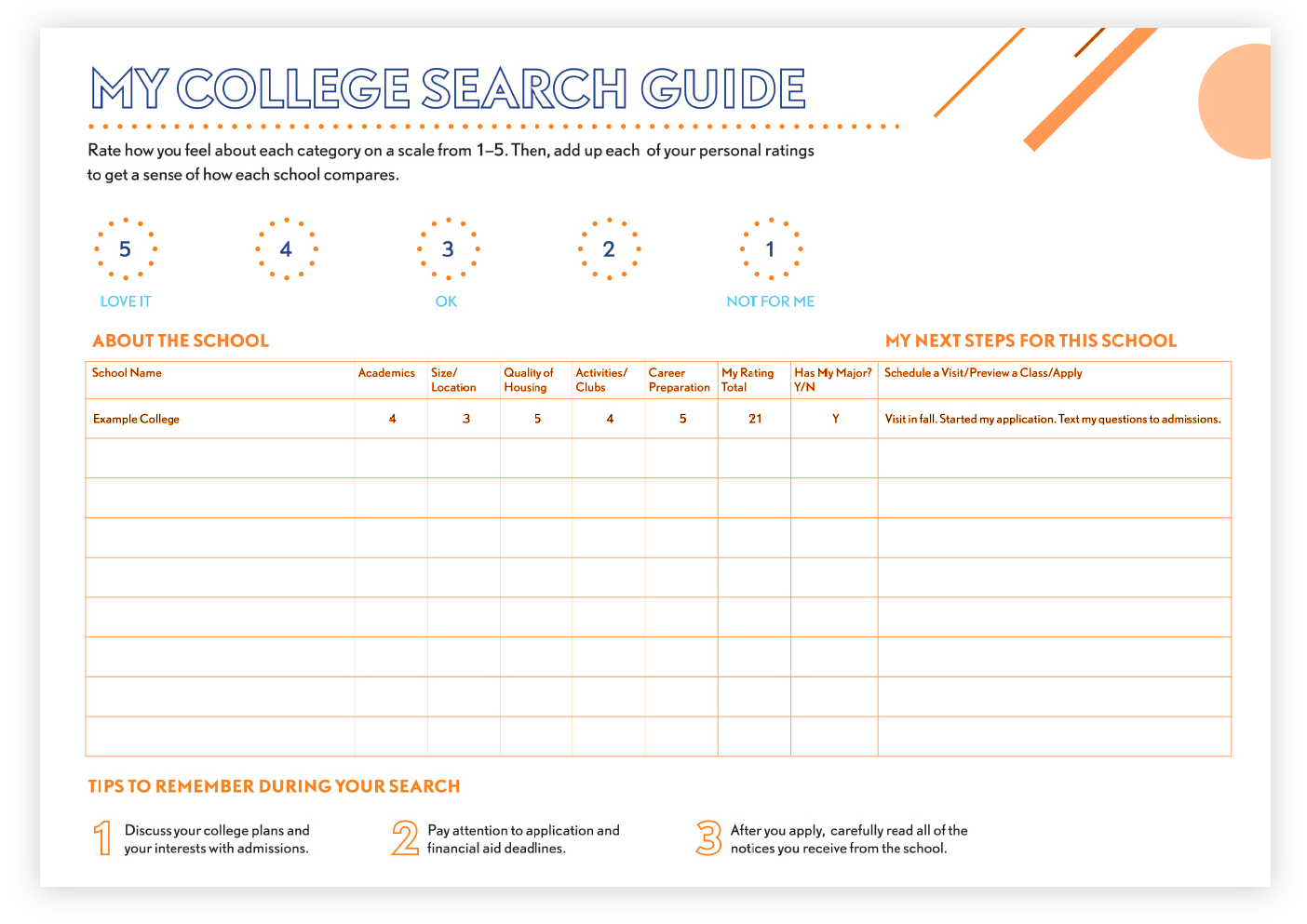
Rule of thumb: All applicable information for admitted students should be in one place and easy to find. At Spark451, we provide a robust personalized microsite for admitted students. This is where students can find all of the details needed to make a well-informed decision about where to attend. (We’d be happy to discuss our personalized microsites with you more, so your school can maximize its ability to provide all necessary information to admitted students and their families.)
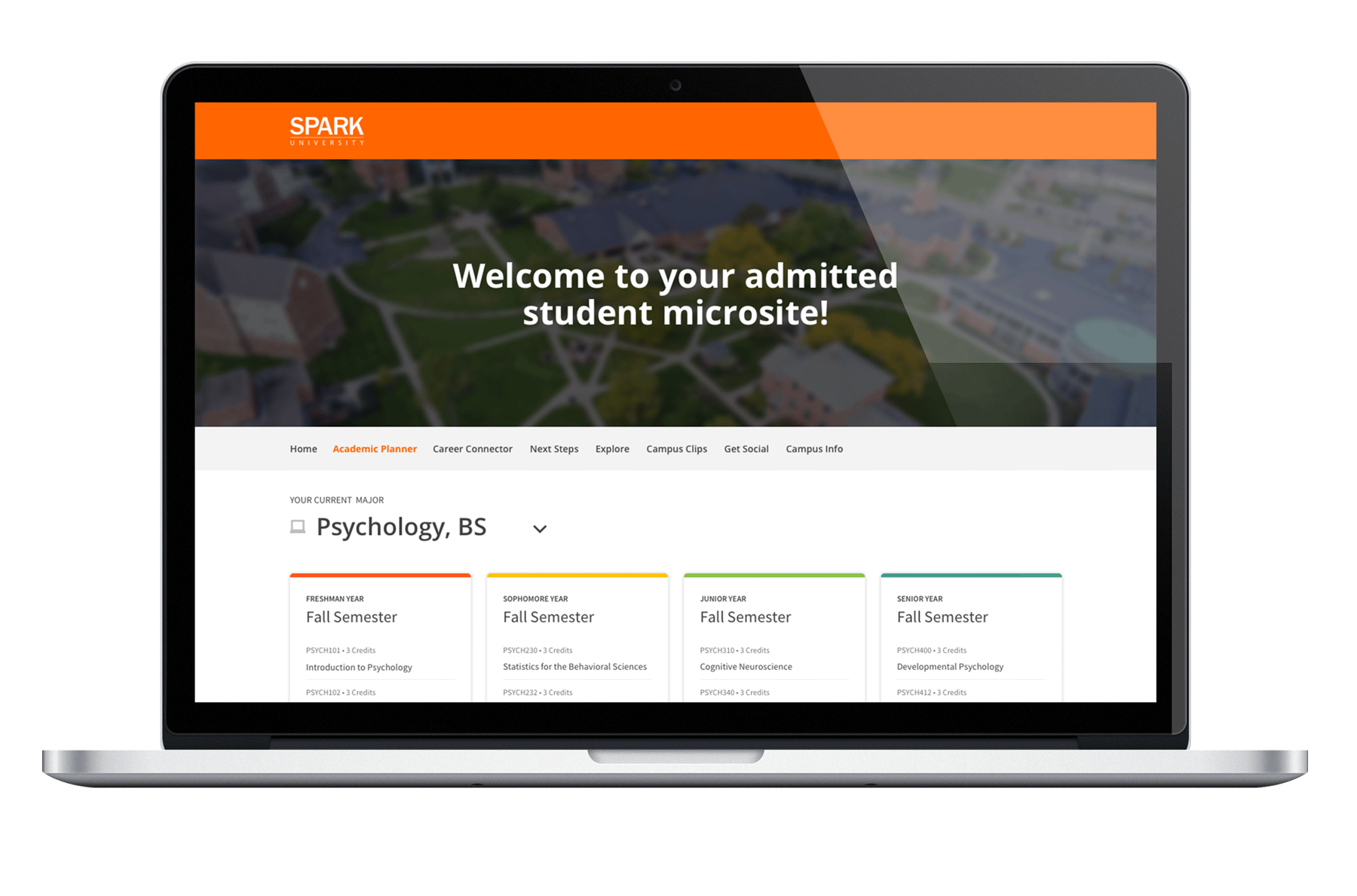
These are tips you can start implementing today, but here at Spark451, we also offer more robust, larger scale yield strategies. We would be happy to discuss how we can help assist your school with yield and meet your enrollment goals — reach out today!
Save the Date for the 2023 SparkThink@JAM: Special Interest Forum on Enrollment and Technology
Save the Date for the 2023 SparkThink@JAM: Special Interest Forum on Enrollment and Technology
The teams at Spark451 and Jenzabar are thrilled to announce the launch of SparkThink@JAM, our first annual special interest forum on enrollment marketing, strategy, and technology!
Taking place during this year’s 22nd Jenzabar Annual Meeting (JAM), SparkThink@JAM is a new session track dedicated to sharing information and ideas on topics related to enrollment management, admissions, marketing, and technology. It will offer attendees three days of educational sessions, roundtable discussions, and networking opportunities.
This spring, more than 1,300 of your colleagues will be heading to JAM to focus on higher ed tech and the platforms driving your institutions. We hope you’ll join them — and us — in Orlando for a meaningful and memorable event focused on the latest innovations in admissions and enrollment marketing.
Additional details and registration information will follow. In the meantime, please mark your calendar:

SparkThink@JAM
Wednesday, May 31–Friday, June 2, 2023
Gaylord Palms Resort, Orlando, FL
We can’t wait to see you there! If you have any questions, feel free to reach out.
Interested in being a content contributor and sharing some of the great work you’re doing on campus? Be on the lookout for our call for session proposals, or email us now at [email protected].
Digital Marketing Excellence: Spark451 and Collegiate Partners Earn 12 New Awards
WESTBURY, NEW YORK — Higher education marketing firm Spark451, a Jenzabar company, is proud to announce that several recent digital marketing projects — launched in cooperation with its valued partner institutions — earned recognition in the latest Education Digital Marketing Awards.
“From websites, to videos, and paid social ads and beyond, we develop our user-friendly and data-driven digital projects to help colleges and universities connect with students and achieve meaningful enrollment results,” says Irene Scala, Executive Creative Director at Spark451. “It’s truly an honor that our efforts are also being recognized by our peers in the industry. The Spark451 team is thrilled to share these awards with our partners.”
Here’s our latest award-winning work:
Adler Graduate School
Category: Institutional Website (Gold)
Project: Website Redesign
NYU — Center for Urban Science + Progress (CUSP)
Category: Digital Special Video: Over 2 minutes (Gold)
Project: Video
RIT Certified
Category: Admissions Website or Microsite (Gold)
Project: RIT Certified Microsite
Rockland Community College
Category: Admissions Website or Microsite (Gold)
Project: Rockland Community College Workforce Landing Page
University of Maine Fort Kent
Category: Institutional Website (Gold)
Project: Website Redesign
University of Medicine and Health Sciences
Category: Instagram (Gold)
Project: UMHS Cost Comparison Animation Instagram Ad
Lehigh University College of Health
Category: Admissions Website or Microsite (Silver)
Project: Graduate Landing Page
NYU Tandon School of Engineering
Category: Digital Special Video: Over 2 minutes (Silver)
Project: Biotech Video
West Virginia Wesleyan College
Category: Digital Special Video: Under 2 minutes (Silver)
Project: Nursing Video
DePauw University
Category: Social Media Content - Single (Bronze)
Project: Admitted Yield Snapchat Ad
New York University
Category: Instagram (Bronze)
Project: Home for the Weekend Instagram Ad
West Virginia Wesleyan College
Category: Digital Special Video: Under 2 minutes (Merit)
Project: Discover Yourself Campaign
Reach out to discuss how Spark451’s award-winning team can help your institution gain a competitive edge.
What It Means to Be Countercyclical
TOTAL CONVICTION: EPISODE 6
What it Means to be Countercylical
In the latest installment of our video series, “Total Conviction,” Vice President of Business Development Steve Kerge discusses how higher education enrollment tends to rise during economic downturns and offers advice on how colleges and universities can position themselves to thrive in the next new months and years. Check it out above!
When you’re ready to discuss specific strategies for promoting your graduate and adult learner programs, please reach out. Our enrollment strategy experts will be happy to help you develop a plan that will support your goals.
You can also revisit the full collection of “Total Conviction” videos here!
Coming to Inboxes Near You: BIMI
Despite how it sounds, BIMI (pronounced: bih-mee), is not another type of cryptocurrency, another Gen Z acronym, or the name of a celebrity’s newborn.
It’s Brand Indicators for Message Identification (obviously!), or BIMI for short. It’s a way for brands to stand out in the email inbox with their logo, ultimately increasing visibility, engagement, and trust with their recipients. Recently, more and more Email Service Providers (ESPs), like Gmail, Yahoo Mail, AOL, etc., are starting to support BIMI. In fact, as of late October 2022, Apple Mail is supporting BIMI with the recent updates for iOS 16 and macOS Ventura.
At Spark451, we believe now is the time for colleges and universities to consider using BIMI to make an even stronger impression on students via their email marketing efforts. Read on for more details on how BIMI works and why it’s right for higher ed. We’ll even tell you how to set it up!
What is BIMI?
In layman’s terms (we’re not getting technical yet), BIMI allows brands to show their logos in the inbox next to their messages.
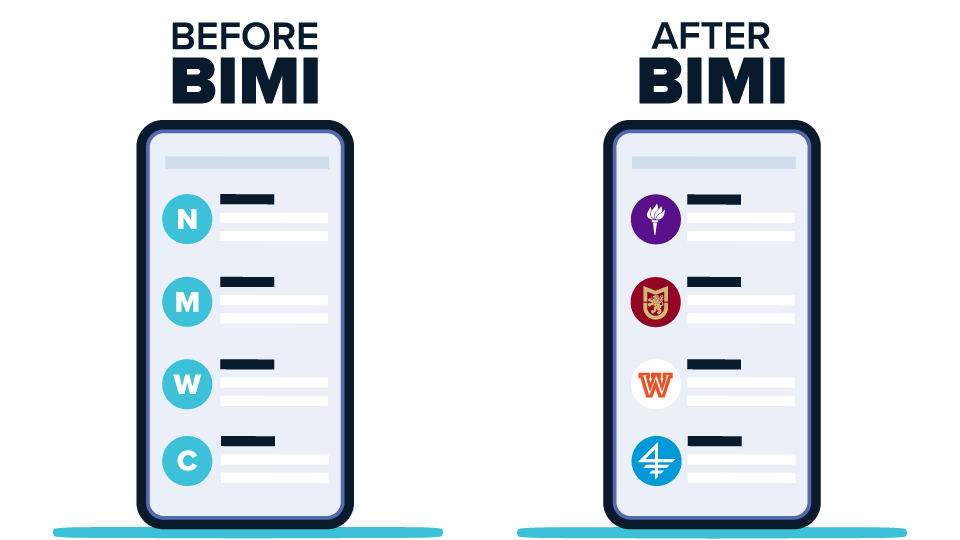
Interestingly, BIMI was not necessarily created with marketing in mind, but moreso to make the email industry more secure. In a world where email scams and phishing are more prevalent than ever, there are specific email sending authentications needed in order for BIMI to work. (More on those specifications later.)
Think about it: If someone knocks on your door claiming to be Ed Sheeran and offering you free concert tickets without showing his face, would you trust them and open the door? I would hope not — that sounds sketchy! But if he shows his face and it is actually THE Ed Sheeran, you would most likely open the door! Admittedly, opening college marketing emails isn’t as exciting as opening your door to Ed Sheeran, but you get the point. There’s more trust when you see a face, or logo.
Why is this a BIG DEAL for higher ed?
Initially, BIMI was only supported by a few ESPs, but now that Gmail announced their support of BIMI in July 2021, and now that Apple Mail is also on board, BIMI is officially a big deal for us as college marketers. Those ESPs represent a significant portion of our prospective student audience, at roughly 75–85%. Gen Z is a very visual bunch (looking at you, TikTok) and BIMI provides an opportunity to catch their attention in their already-flooded-with-college-marketing inboxes. Jumping on the BIMI train will be vital to the success of your email marketing campaigns.
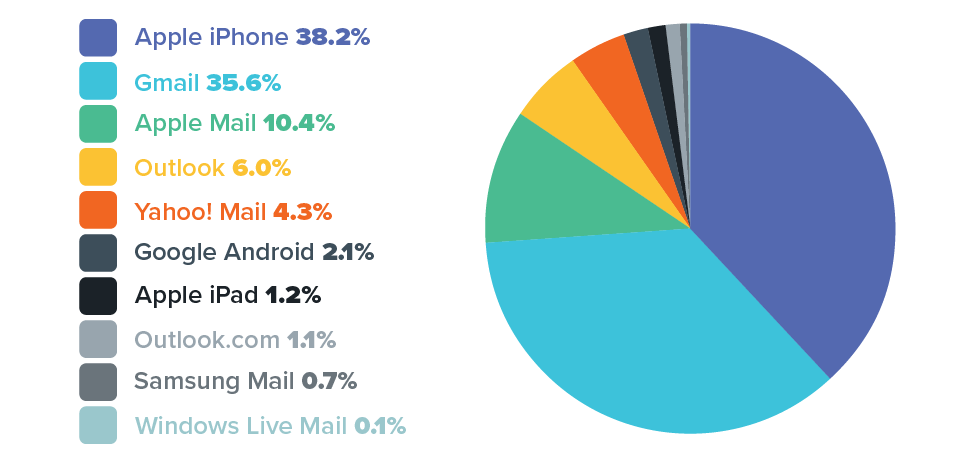
Other benefits to implementing BIMI?
I. Increased Open Rates
Based on the Yahoo Mail BIMI beta program, open rates increased by an average of 10% for emails using BIMI. Some studies even found that brand competitors that did not use BIMI showed a decrease in open rate, and that customer purchasing decisions were negatively impacted. This is your chance to stand out among competitor schools in the inbox — especially right now, while most schools don’t have BIMI.
II. Improved Email Deliverability (Inbox Placement)
Besides the obvious benefit of standing out in the inbox and attracting more opens, BIMI indirectly improves email deliverability, or inbox placement. By implementing BIMI, ESPs will see the increase in email engagement, proving that you’re sending legitimate and relevant messaging, AND that you’ve set the highest level of security to protect their users from phishing scams. Ultimately, the job of ESPs is to keep their users (our recipients) happy and safe. In turn, ESPs reward us by keeping our messages out of the spam folder and by giving us the privilege of showing our logos in the inbox: ✨BIMI✨
How is BIMI implemented?
A few requirements need to be met in order to implement BIMI into your email marketing. You’ll most likely require assistance from your IT/web team.
Step 1: Ensure email sending authentications are set up properly, specifically the DMARC policy
To send emails legitimately and not be classified as a spammer, there are specific sending authentications that must be aligned in your DNS records: Sender Policy Framework (SPF) and DomainKeys Identified Mail (DKIM). Something that makes BIMI a little more complicated to obtain is setting the proper Domain-based Message Authentication, Reporting, and Conformance (DMARC) record, or DMARC policy.
There are 3 types of DMARC policies: None, Quarantine, and Reject. Each can be thought of as a security level — with a policy of Reject being the highest — and ultimately protects your domain from being spoofed. Should a spammer impersonate your domain and send on your behalf, the DMARC policy would route their emails to spam (if the policy is set to Quarantine), or block their emails completely (if the policy is set to Reject). BIMI will only work if there is a secure DMARC policy in place, either Quarantine or Reject.
Step 2: Provide logo in a secure format with specific parameters
BIMI requires that a logo be in Scalable Vector Graphics (SVG) format to provide the highest quality image in the inbox for all devices. Overall, logos must be centered, have a solid background, a square aspect ratio, and be under 32 kilobytes. The logo must also be hosted on a publicly accessible server. This is how the BIMI record will “call in” and render the logo into the recipient’s inbox. Here is a detailed list of the BIMI logo specifications.
Step 3: Obtain a VMC
Step 4: Publish the BIMI record in your DNS
After you’ve jumped through the above hoops, the BIMI record can be added into the DNS. There are various tools that can help generate the BIMI record and confirm that it’s set up properly, like the BIMI LookUp & Generator. It can take anywhere from 24 hours to up to a few weeks for the logo to start appearing in the inbox.
Of course, BIMI is just the tip of the iceberg when it comes to delivering impactful email marketing campaigns for higher ed. Spark451’s email marketing experts and strategists can help you through everything from the technical aspects of implementing BIMI for your institution, to planning, crafting, and delivering robust, highly personalized campaigns that will support your enrollment goals. Feel free to reach out whenever you’re ready to talk.
Admissions and Enrollment Marketing Expert Brian Jansen Joins Spark451
Westbury, NY — Spark451, a Jenzabar company, is proud to welcome Brian Jansen, our newest Senior Business Development Strategist. Based in Portland, Oregon, Jansen will work closely with the company’s partner institutions primarily in the Midwest and Pacific Northwest to help them achieve their enrollment goals.
“Brian brings a great deal of valuable experience to this role,” says Steve Kerge, Vice President of Business Development, Spark451. “He’s spent significant time both in the trenches of various collegiate admissions offices and as a trusted strategic partner on the agency side. I’m very enthusiastic about the insights and support he will be able to deliver to our partner colleges and universities.”
Jansen holds a BA in psychology from St. Norbert College and an MS in marketing communication from Illinois Tech’s Stuart School of Business. For more than two decades, he has been moving the admissions needle for higher education institutions. Jansen started his career working his way up through the admissions and marketing ranks at a handful of campuses in the Chicagoland area, including Trinity International University, Illinois Tech, and The Chicago School of Professional Psychology. At different points of his journey, he gained experience serving a variety of audiences including traditional undergraduate students, non-traditional adult degree completion students, and graduate students. At one point, he even managed to boost enrollment for one institution by a whopping 20 percent in his first year!
In 2010, Jansen transitioned from on-campus roles into enrollment consulting. In the last 12 years, he has partnered with well over 75 institutions from around the country. Along the way, he has helped schools refine their recruitment and enrollment strategies, implemented multi-channel student search and application generation campaigns, and delivered data-driven funnel qualification via predictive modeling.
“I am thrilled to be able to continue helping higher ed institutions identify ways in which we can collaborate to achieve their specific goals and face challenges head on,” says Jansen. “To me, the relationships I’m able to build with partner institutions and their hardworking teams is the most rewarding, and it’s what I’m most excited about in this new role with Spark451.”
About Spark451
Spark451, a Jenzabar company, is a higher education enrollment strategy, technology, and marketing firm that combines creativity with powerful technology to achieve measurable results. With a mission to help colleges and students fuel their future, the firm integrates a multitude of communication channels and platforms for effective enrollment marketing, student search, creative services, and digital media. Since 2011, Spark451 has worked with over 200 colleges and universities nationwide. For more information, please visit spark451.com.
Looking Further Down the Funnel
Blog
By Erika Forrest-Martin and Ryan Hogan
Working in higher education right now can feel like walking in a blizzard. Everyone is doing their best to put one foot in front of the other without being able to see too far ahead. We’ve all been there. It’s very common to lose sight of anything beyond the next step — especially as the recruitment and application season picks up. However, this is also the exact reason it is important to plan ahead. Trust me, future-you will thank you.
In our recent College-Bound Student Survey for the Class of 2026, 65% of students indicated that they began to seriously look at college prior to the summer of their senior year. What is your plan to start engaging students before their senior year begins?
Let’s focus on an effective sophomore/junior search. Building early brand awareness is the foundation upon which you can begin to widen your funnel, putting your enrollment goals within reach. Being familiar with your institution is a prerequisite for students’ curiosity: When surveyed, almost 45% of the Class of 2026 said they would not open an email from a college if they had never heard of it. So, how can you make sure they’ve heard of you? Read on to see how we break it down step by step, focusing on the “who,” “how,” “when,” and “where” of an effective sophomore/junior search.
65%
of students indicated that they began to seriously look at college prior to the summer of their senior year
45%
of the Class of 2026 said they would not open an email from a college if they had never heard of it
Step 1: Figure out who you’d like to connect with.
What kind of students do you want to enroll? Where are they? What are their interests? Oftentimes, answering these questions is a daunting task in and of itself! Using tools like Spark451’s Purchase Modeling and Predictive Modeling can make this a breeze. By analyzing your institution’s historical data and comparing it with national enrollment trends, we can help you make a strategic name purchase, and then assign a score to those names ranking the likelihood of their enrollment.
Step 2: Determine how to talk to them.
27% of students from our College-Bound Student Survey indicated that they did not open an email from a college if it was too generic. While keeping brand messaging simple and clear is important, adding personalization is the name of the game. This is the Instagram/TikTok generation, where everyone has their own page, their own individualized timeline — and uniqueness is often celebrated. Getting creative with segmentation and personalized messaging is a great way to begin your relationship with these students.
Once you’ve managed to capture their attention, providing easy ways for them to indicate their interest is very important! Make sure you have a user-friendly lead form that is easily accessible in all of your communication channels.
Step 3: Plan for where you'll talk to them.
Multi-channel communication plans are going to be the most effective tools for building brand awareness. To start, introducing yourself through digital media is an excellent way to foster passive engagement. Having a social media presence on Instagram, TikTok, and Snapchat — or even better, running ads on these channels — is an excellent way to make your name more recognizable.
Of course, email will be the primary vehicle to discuss who your institution is and what it has to offer. 95% of students noted that they used email for their communication during their college search, with mailed materials (47%) and texting (43%) coming in as the next most popular channels. Reflective of this, students ranked email as their preferred communication method, with traditional mail coming in second and texting coming in third. (Also, 30% of respondents noted they were OK with receiving texts anytime!)
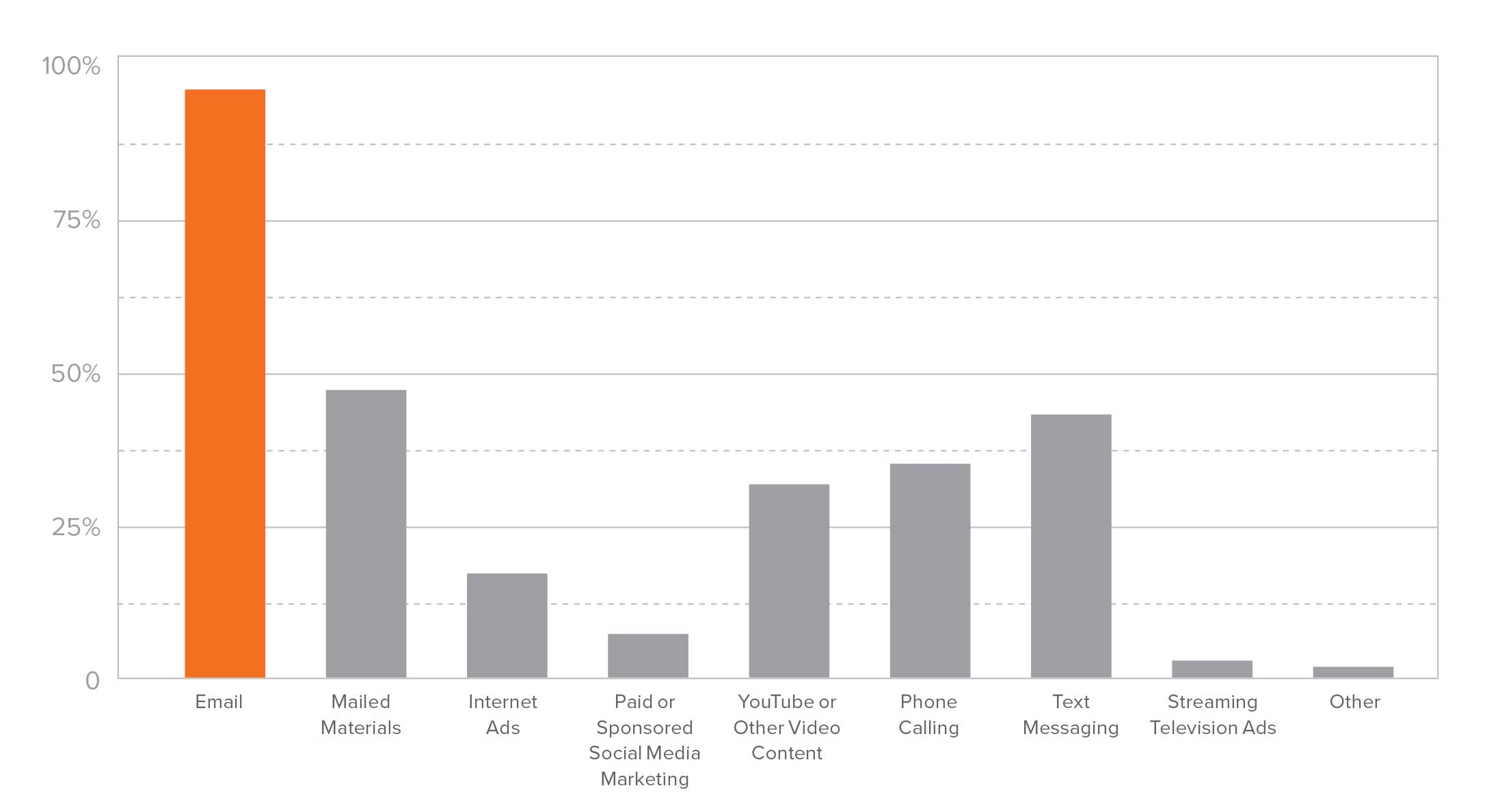
Once you’ve established your multi-channel communication plans, you can start passing the baton to your admissions counselors. Spring high school visits and college fairs are the best time to connect with sophomores and juniors in their natural habitat. In fact, according to our College-Bound Student Survey, almost 40% of students preferred to research a college with presentations/visits at their school. Pairing data insights from your communications with the student names you purchased (and potentially scored) can help you determine where to travel for the spring. Additionally, these trips provide the opportunity for counselors to make a personalized connection, as they can enter each visit with a list of students they know have already received and/or engaged with your communications. Making a good impression here, with the right students, is a recipe for success! (Did reading this just remind you that you need materials for the road? We can help with that, too!)
Another way to build relationships is to offer specific visit opportunities for sophomores and/or juniors on your campus. After all, 27% of the students we surveyed indicated that they knew their chosen school was right for them immediately upon visiting campus, so any way you can get students to your campus will likely result in a boost in enrollment later on. Something like a “Tips and Tricks for College Admissions” workshop could be a great way to garner interest from sophomores and their parents. For juniors, focusing more on your campus, scholarships, academic opportunities, etc., may be more appropriate.
Step 4: Engage the stakeholders.
We know parents/guardians are a huge factor in a student’s college search, with 88% of surveyed students indicating that their families had an impact on their college decisions. Engaging parents/guardians through their own specific campaign (separate from their students), is a very effective way to build brand recognition and establish relationships with these key influencers. Tailoring these messages to make them feel personalized is paramount, as the way you’d engage with a first-generation family may sound very different than how you might speak with a parent who is an alum, for example. At Spark451, we have the ability to append parent/guardian data to purchased names, making it easy to include them in your communication plans.
In a nutshell, running a successful sophomore/junior search comes down to playing a strategic long game in a thoughtful way. We know there are plenty of students who would be a great match for your institution — the challenge is finding them early enough in the process so that they are excited when it comes time to apply. Ensure you are talking to them as an individual so the student feels that any email, text, or postcard you’ve sent was meant for them — it can really make all the difference! If students and their families feel special, and that your school genuinely cares about them and their academic future, they’re going to be more likely to enroll.
To further discuss the details of your college or university’s sophomore-junior search, please reach out. We’ll be happy to help you refine your strategy and deliver a campaign that will support your goals. Trust us, future-you will thank you!
